GIGABYTE F2A88X-UP4 Review
by Ian Cutress on March 24, 2014 11:59 AM EST- Posted in
- Motherboards
- AMD
- Gigabyte
- FM2
GIGABYTE F2A88X-UP4 BIOS
When I received the motherboard, it contained the F2 BIOS, which was based on Richland APUs and my Kaveri APUs would not work. In order to update the BIOS, I installed an A10-6800K and attempted to updated the BIOS through Q-Flash in the BIOS itself. This did not work (the BIOS file was not recognized), which in the past usually means installing an OS and updating via @BIOS. I did this, updated to BIOS F5b and reinstalled the OS under Kaveri to keep our testing consistent. With this scenario in place, it worries me slightly that resellers of this motherboard, who have excess stock, might not update the motherboards for Kaveri APUs. Users should be aware of this (not just with GIGABYTE but with everyone) and ask that the BIOS be updated before they take receipt of their product. I know of a few retailers in the UK that would do this on request, and I hope others like Newegg are on the ball.
The GIGABYTE FM2+ BIOS mirrors the classic mode we see from the Z77 and Z87 models, featuring a graphical system but a text-based layout with images. On the front screen we get the BIOS version, CPU frequency, memory frequency, CPU temperature, voltages and memory size installed. Perhaps two of the biggest omissions in this list is the name of the motherboard being used and the CPU installed, both bits of information that system builders might find useful if they work with many systems or are unable to actually access the inside of the PC case.
The MIT Current Status screen shows the CPU name along with memory subtimings and exact information about memory module installation. The overclocking options are in the next few menus, and GIGABYTE is maintaining consistency by separating the frequency, memory and voltage settings into their own menus.
Frequency settings include the CPU and the DRAM options, as well as advanced CPU Core settings (Turbo, cTDP and another ratio setting). One thing that GIGABYTE has lacked in this area with this type of BIOS is automatic overclock settings for the user, although with their new Z87 BIOS topology they do have options there. Although I wonder if that will be ported to AMD – if this were a performance platform then it would have happened by launch.
Fan controls are in the PC Health Status menu option under the MIT tab:
The preset options include Normal, Silent and Full Speed, whereas the manual option allows users to define the fan gradient in terms of PWM/degrees Celsius. This is an annoying scale to work in. Users must recognize that the PWM value (power applied to the fan) is on the scale of 0 to 255, with higher being more power. Then there is the issue that fan speed is not directly proportional to the power applied – some fans do not engage until 10% power is applied or a fan will run at 30% RPM when the power is less than 20%. Other motherboard manufacturers are on their way to producing a solution, but GIGABYTE are still on this older method.
The System Information tab contains details about the motherboard model name. I feel it would take a BIOS engineer less than five minutes to add the code to display this data on the MIT tab when a user enters the BIOS.
In the BIOS Features tab, users select their boot priority as well as Fast Boot options for Windows 8. The Peripherals tab includes options for onboard controllers and onboard graphics selection. Finally of note is the Boot Override option in the Save and Exit menu, allowing users to select a single device for a one-off boot.
GIGABYTE F2A88X-UP4 Software
The FM2+ software from GIGABYTE is also a step back in time if you have been following our Z87 coverage. We only have two user interactive utilities, @BIOS and EasyTune6. EasyTune6 had a rough ride, as we had to request a special version from GIGABYTE in order to get it to work. There is some issue with the EasyTune coding and the integrated graphics on Kaveri such that GIGABYTE had to disable IGP overclocking on EasyTune6 to get it to work. GIGABYTE should be providing an updated version on their website in order for users to be able to get to grips with the ET6 software.
@BIOS
Almost all motherboard manufacturers offer various ways of updating a BIOS. The two main ways are through the BIOS itself, or through software in Windows. @BIOS is GIGABYTE’s software implementation, and offers to download an update the BIOS for the user or update via a file.
EasyTune6
Before Z87, EasyTune6 was GIGABYTE’s main software platform for combining all the operating system features. The first screen when opened in the Tuner menu, offering three overclocks:
Users can delve into the ‘Easy’ and ‘Advance’ options at the top to access ratios and voltages:
The other tabs on the interface include CPU information, DRAM information, fan controls and a basic ‘hardware’ monitor. The fan controls are similar to that seen in the BIOS, although the user has larger control of the gradient of fan power to temperature.


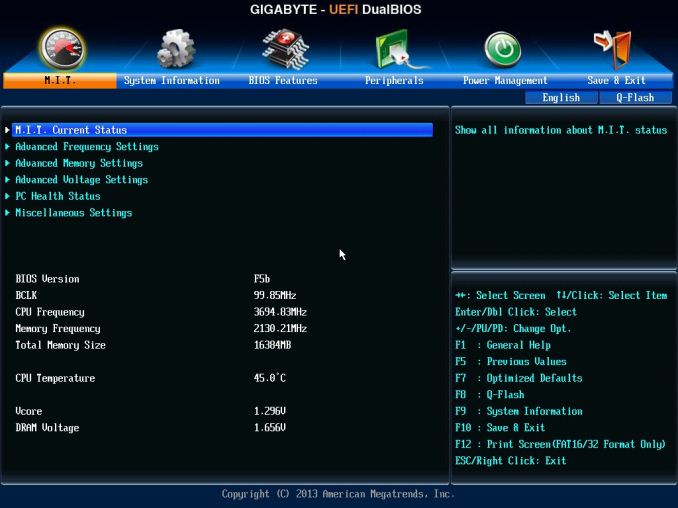
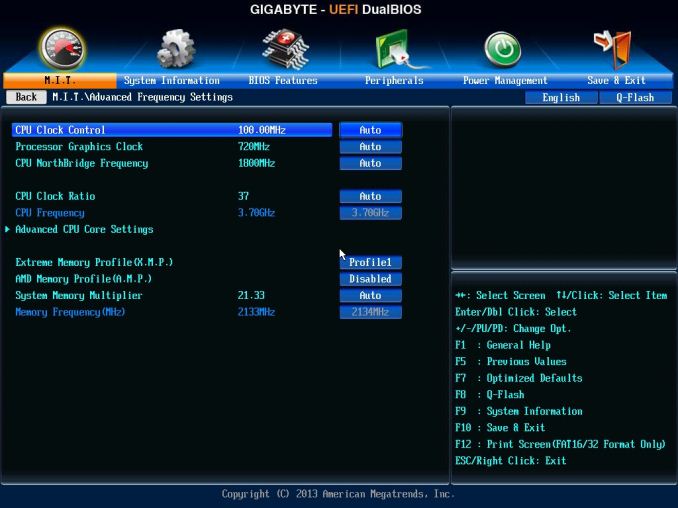
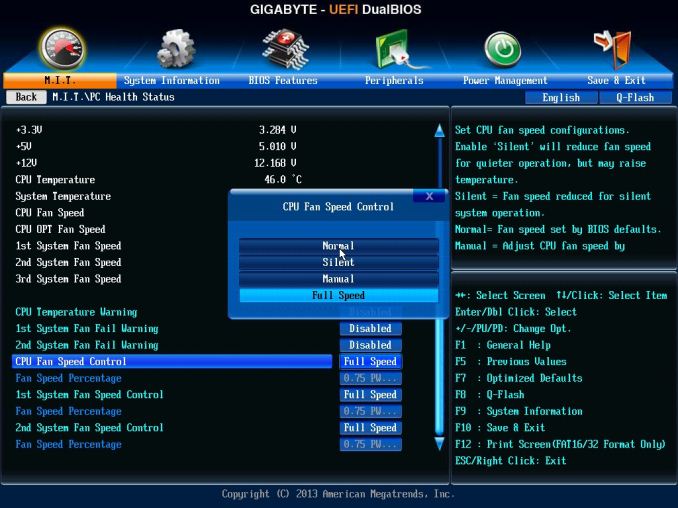
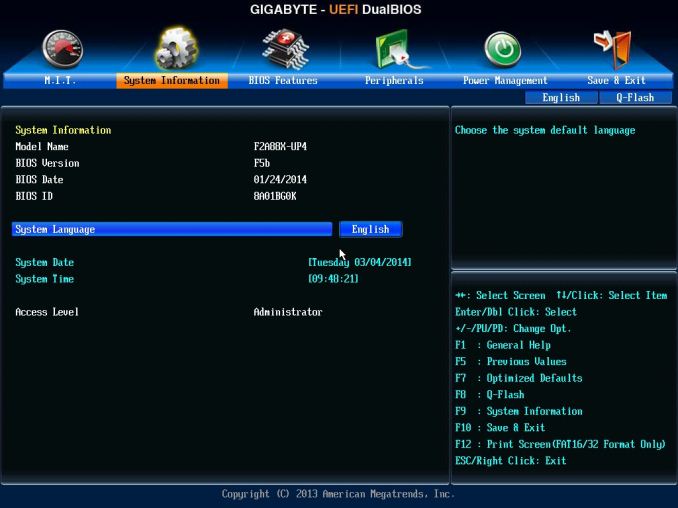






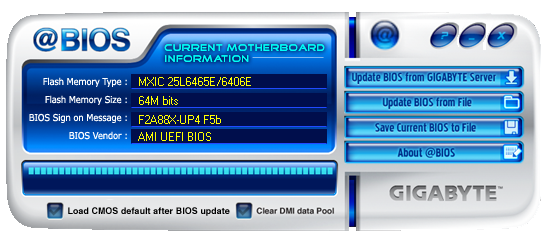
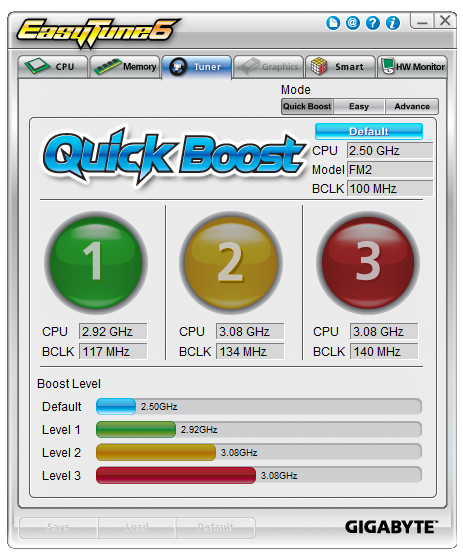
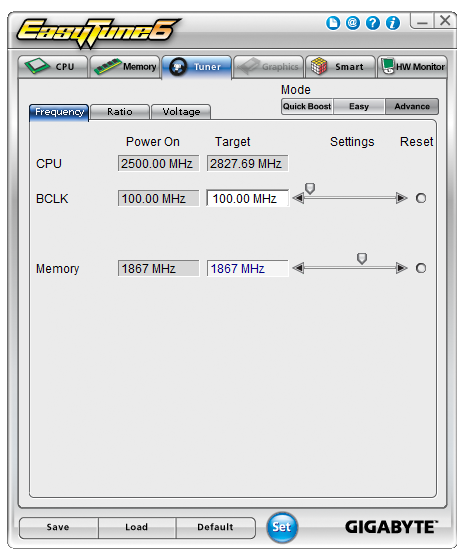

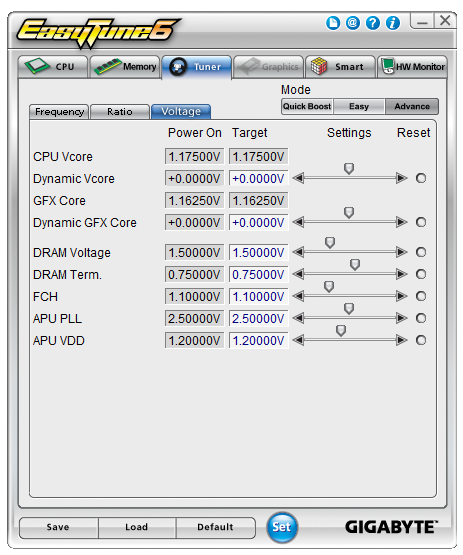
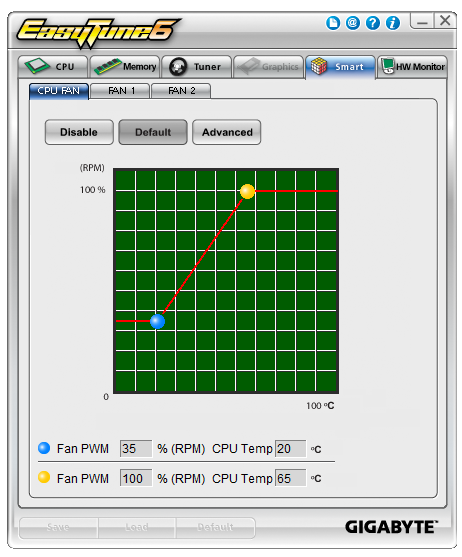














18 Comments
View All Comments
apertotes - Monday, March 24, 2014 - link
The old EasyTune software may end up being a blessing in disguise. The newer Intel software has a nasty issue with global hotkeys and some non-English keyboard layouts. Those hotkeys can not be disabled or remapped and take control of some very usual key combinations like @,# or €.DukeN - Monday, March 24, 2014 - link
Good mining board - inexpensive combined with a cheap AMD proc, even has onboard power button wired in.popej - Monday, March 24, 2014 - link
Again dynamic range "From Graph"? Can't you believe, that numeric value and provided graph are only different presentation of the same result?Noise level drawn on the graph directly depends on FFT size, make FFT calculation with twice the size of data and it will drop by 3dB. RMAA probably draws graph normalized to 1Hz FFT bins, but it is only a convention, nothing there can suggest 102dB DNR.
StevoLincolnite - Monday, March 24, 2014 - link
I'm really not all that interested in ATX sized FM2+ boards.However, where I think there is a gap that needs to be filled is actually in the AM3+ sector.
SERIOUSLY Where are the ITX based AM3+ boards!?
I have a Phenom 2 x6 and an FX 8120 laying around that would love to find their homes in a Mini-ITX system.
meacupla - Tuesday, March 25, 2014 - link
I think it's just not possible to load up an ITX board with that many voltage regulators.Asrock's first FM2 ITX board went up in flames, and an A10 is lower power than Phenom or FX.
bdub951 - Monday, March 24, 2014 - link
ITX is where FM2+ shines. We really need a look at the various FM2+ ITX offerings. I've dealt with the GA-F2A88XN-WIFI and while the board itself is very nice, the BIOS and software really needs some work. Overclocking is a mixed bag on FM2+ due to the CPU throttling to 3Ghz under iGPU load. iGPU overclocking is the most important distinguishing factor between boards and the GA-F2A88XN-WIFI (possibly the rest from Gigabyte too) doesn't appear to allow the iGPU to clock beyond 960Mhz even though you can set it higher in BIOS.DrMrLordX - Monday, March 24, 2014 - link
The 3 ghz P5 state throttling under iGPU load can be defeated:http://www.overclock.net/t/1459225/i-have-custom-l...
. . . but it isn't an elegant solution. I think the UP4 has been reported to restrict iGPU overclocking to 960 mhz by some folks at overclock.net, but my memory is fuzzy on that point.
bdub951 - Tuesday, March 25, 2014 - link
I'm a little disappointed that Anandtech isn't able to look into issues like this. I think it's pretty important to know these things when determining what CPU and MB to go with. Why even bother with determining what CPU OC a board will support when the use of your iGPU just causes it to throttle to P5 making the OC useless. Given this appears to be a TDP limitation that is designed into Kaveri, wouldn't it make more sense to determine the iGPU OC??Now whether this TDP limitation affects the iGPU also remains to be seen but there are reports that the iGPU throttles to 450Mhz randomly causing stuttering when it's OC'd. I believe MSI afterburner shows this.
Regardless, I think it's time for a little more disclosure from AMD as to whats happening. This is supposed to be an unlocked processor but it's clearly locked. Whether you lock via clocks, multiplier, or TDP is irrelevant, it's still locked.
DrMrLordX - Tuesday, March 25, 2014 - link
Allegedly, MSI Afterburner can be used to defeat iGPU throttling, though at least one person I've talked to has voiced the opinion that the throttling behavior may be due to excessive polling by software such as . . . MSI Afterburner (and the person I am citing may step forward to elaborate, if he wishes).As far as the p5 state throttling, some boards are supposedly able to defeat that behavior by toggling a setting such as advanced power management (APM), but it is not 100% clear whether or not that is effective. Some boards do not offer this option in their UEFI.
I agree that more disclosure and coverage of throttling issues on Kaveri would be nice. Published benchmarks are all potentially tainted by throttling behavior. I don't fault the reviewers really, Kaveri is just an odd chip. Power delivery seems to be a major concern on the FM2+ platform when hosting a Kaveri CPU.
rozquilla - Monday, March 24, 2014 - link
The link to the AMD A10-7850K (ES) processor actually links to the Intel Core i7-4960X.